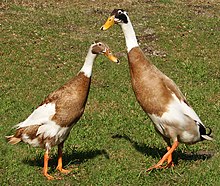Indian Runner Duck
 |
|
| Traits | |
|---|---|
| Weight |
|
| Skin color | Pink |
| Egg color | Greenish blue |
| Comb type | None |
| Classification | |
| PCGB | light |
|
|
Indian Runners are a breed of Anas platyrhynchos domesticus, the domestic duck. They stand erect like penguins and, rather than waddling, they run. The females usually lay about 150 to 200 eggs a year or more, depending whether they are from exhibition or utility strains. They were found on the Indonesian islands of Lombok, Java and Bali where they were 'walked' to market and sold as egg-layers or for meat. These ducks do not fly and only rarely form nests and incubate their own eggs. They run or walk, often dropping their eggs wherever they happen to be. Duck-breeders need to house their birds overnight or be vigilant in picking up the eggs to prevent them from being taken by other animals.
The ducks vary in weight between 1.4 and 2.3 kg (3.1 and 5.1 lb). Their height (from crown to tail tip) ranges from 50 cm (20 in) in small females to about 76 cm (30 in) in the taller males. The erect carriage is a result of a pelvic girdle that is situated more towards the tail region of the bird compared to other breeds of domestic duck. This structural feature allows the birds to walk or "quickstep", rather than waddle, as seen with other duck breeds. Indian Runner ducks have a long, wedge-shaped head. The bill should blend into the head smoothly being as straight as possible from bean to the back of the skull. The head should be shallower than what is seen with most other breeds of duck. This effect gives a racy appearance, a breed trait. Eye placement is high on the head. Indian Runners should have long, slender necks that smoothly transition into the body. The body is long, slim but round in appearance. The eggs are often greenish-white in color. Indian Runners have tight feathering. Drakes have a small curl on the tip of their tails, while hens have flat tails. It's difficult to determine their sex until they are fully mature.
They often swim in ponds and streams, but they are likely to be preoccupied foraging in grassy meadows for worms, slugs, even catching flies. They appreciate open spaces but are happy in gardens from which they cannot fly and where they make much less noise than call ducks. Only females quack and drakes are limited to a hoarse whisper. Compared to big table ducks, they eat less grain and pellet supplements. When they are young, they eat rocks to form their gizzard which helps them digest their food. They do not have teeth, so they must have water to soften food.
The Indian Runner ducks are domesticated waterfowl that live in the archipelago of the East Indies. There is no evidence that they came originally from India itself. Attempts by British breeders at the beginning of the twentieth century to find examples in the subcontinent had very limited success. Like many other breeds of waterfowl imported into Europe and America, the term 'Indian' may well be fanciful, denoting a loading port or the transport by 'India-men' sailing ships of the East India Company. Other misnamed geese and ducks include the African goose, the black East Indian duck and the Muscovy duck.
...
Wikipedia
